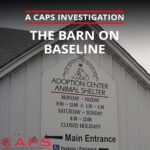Breeder: Yoder, Andy
City, State Zip: Millersburg, OH 44654
Year: 2005
USDA License: 31-A-0109
Date of CAPS Investigation: 2005-03-03
Approximately 33 dogs and two puppies; seven of the dogs were Beagles that the owner’s wife said were for hunting and not breeding. Breeds: Scottish Terriers, Pomeranians, Beagles, Cairn Terriers, Shiba Inus, Boston Terriers
Barn with indoor/outdoor pens
The kennel consisted of several structures. The largest was a single-story building 12 feet long and five feet wide. It had plastic siding, tile roof, a single door with a window providing access on one five-foot wall, and a window on the opposite five foot wall. There were four pens on each longer side of the barn. Each pen consisted of an indoor and outdoor cage, connected by wooden doggie-doors.
The outdoor cages were each about 2.5 feet long, wide, and high and constructed entirely of treated wire. They were set about three above the ground and had plastic sheeting a foot beneath them supported by PVC piping to catch feces and debris. There was more than 24 hours’ accumulation of feces and standing puddles of partially frozen urine on these sheets (3.11(a)-Cleaning of primary enclosures). More than two weeks’ accumulation of feces was below the plastic sheets, and strands of fur and feces were hanging from underneath the plastic sheets and wire floorings (3.11(a)-Cleaning or primary enclosures). The plastic siding of the building underneath the cages was covered in fecal stains and had bits of feces and fur stuck to it (3.1(c)(2)-Surfaces). The PVC piping underneath the cages ran down to the ground and along the wall of the kennel building itself. Thick feces accumulation was caked between the piping and the building (3.11(a)-Cleaning of primary enclosures).
One corner outdoor cage had a cage flooring made of two wire sheets that met in the middle of the cage, where the flooring sagged about three inches lower than the rest of the floor so that the floor itself had a large trench in it (3.1(a)-Structure; construction) (3.6(a)(2)(xii)-Primary enclosures). The outside wall of this cage facing away from the owners’ driveway had a piece of untreated thin-gauge wire between the top of the cage and the treated wire of the wall (3.6(a)(2)(xii)-Primary enclosures). Sharp points of this untreated wire protruded into the cage itself (3.1(c)(1)(ii)-Surfaces).
A lix-it watering system fed each outside cage, though each cage also had a plastic water dish in it that was full of ice (3.10-Watering). A pen housing a whelping Shiba Inu mother and her puppy, who was about two weeks old, had a brick holding down the cage flooring at one of its outside corners (3.1(b)-Condition and site) (3.6(a)(2)(xii)-Primary enclosures).
The four indoor cages along each 12-foot barn wall were each about 2.5 feet long, wide, and high and were raised about a foot above the wooden barn floor. Each cage contained two to four dogs, with each dog being about 10 to 25 pounds in weight. Two cages each contained two adult Pomeranians and two adult Boston Terriers (3.6(c)(1)(i)-Primary enclosures).
These cages had plastic sides and floorings, though the walls facing the inside of the kennel were made of painted, treated thin-gauge wire. Some of the indoor cages had roofs made of painted, thin-gauge wire, some had no roofs. The painted wire was peeling in all of the cages (3.1(c)(2)-Maintenance and replacement of surfaces).
The thin-gauge wire roof of a pen that contained a whelping Shiba Inu mother and a puppy about two weeks old was untreated and rusting (3.1(c)(1)(i)-Surfaces). This roof had two wire sheets that met in the middle, where sharp pieces of wire protruded down into the cage (3.1(c)(1)(ii)-Surfaces). The Shiba Inu mother had several scars on the top of her muzzle, possibly caused by the sharp wire.
Paper cards with what appeared to be the names and birthdates of the dogs hung inside plastic sheets on the wire wall of each cage. One of the cards appeared to be a piece of thin cardboard secured to the top of a cage with a zip tie.
Some cages had plastic food bowls on the cage floorings, while others had plastic self feeders attached to the wall within a couple inches of the floor. None of the food containers were placed so as to minimize contamination by excreta (3.9(b)-Feeding).
Several cages included painted-wood whelping boxes about a foot long, a foot wide, and several inches deep. Paint was worn away from the boxes in several areas, and the box edges were chewed (3.1(c)(2)-Maintenance and replacement of surfaces) In one cage, the whelping box partially covered a six-inch hole in the outside wall, leaving exposure to the outdoors (3.1(a)-Structure; construction)
All of the surfaces inside all of the cages had dirt and feces buildup, many with the white-painted surfaces completely covered with feces buildup. Obviously there was more than 24 hours’ accumulation of feces in each cage (3.11(a)-Cleaning of primary enclosures).
The barn floor between the cages was covered with dirt and mud and appeared to not have been cleaned in more a day (3.1(c)(2)-Surfaces). Lighting in the kennel was provided by windows on each shorter wall of the building, one on the door and another on the opposite wall. Each window was about 1.5 feet high and a foot wide. Below the window on the wall opposite the doorway was a heater that was turned on.
Circular pen
About 40 feet from side of the barn away from the driveway was a pen containing two adult Shiba Inus. The pen was circular, 30 feet in diameter, and fenced with seven-foot-high untreated, thick-gauge rusting fencing (3.1(c)(1)(i)-Surfaces).
Inside was a rusting-metal self feeder on the ground that was not in a manner that would minimize contamination by excreta or pests (3.9-Feeding). Also in the pen was a rusting-metal barrel about four feet long and two feet wide with no windbreak on its entrance (3.1(c)(1(i)-Surfaces) (3.4(b)(3)-Shelter from the elements). This barrel was not large enough for one of the Shiba Inus to be inside and lie in a normal manner or turn about freely (3.4(b)-Shelter from the elements). A wooden branch about 10 feet long was resting unsecured against the barrel and the top of the metal wall (3.1(a)-Structure, construction). A plastic dish on the ground that was about six inches high and wide was filled with ice (3.10-(Watering). There was no spot in this pen where for the dogs could stand or lie down without being on snow (3.4(a)(2)-Shelter from the elements). There was no dry bedding in the dog house or on the ground of the pen (3.4(b)(4)-Shelter from the elements).
Beagle pens
The rest of the kennel consisted of outdoor pens for Beagles. These pens were located between the barn and the driveway accessing the property. Andy Yoder’s wife said that their Beagles were for hunting only.
One of the enclosures consisted of two adjacent wooden cages, each about two feet wide, four feet long, and two feet high and raised about two feet above the ground on wooden stilts. There were two Beagles in each cage. The cages had wooden beams at the corners and wire walls and floorings. There was more than two weeks’ accumulation of feces under each cage.
Three additional pens consisted of dog houses made of untreated wood; each had a Beagle chained to a stake with about ten feet of chain. The dog houses had no windbreaks on their entrances and had food and water dishes set on the ground near them in a manner that would not minimize contamination by excreta.
Download attachments:YoderAndy.pdf




